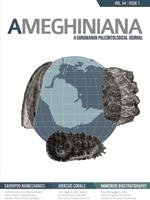Paleobiology is a discipline that attempts to reconstruct the life history of extinct organisms trying to understand in a more complete panorama what organisms did and how they lived. Achieving this goal requires the interaction with other biology disciplines, among which are functional morphology, biomechanics and ecomorphology. These play a fundamental role in the evolutionary analysis of form and function, providing the experimental, theoretical, and mechanical basis for understanding the evolution of organisms. Although focused on fossil vertebrates, the book “Forma y Función en Paleobiología de Vertebrados” (Form and Function in Vertebrate Paleobiology) of Vizcaíno et al. addresses the tools and approaches used in paleobiological analyses providing also a solid theoretical base of the discipline.
The book is divided into nine chapters. The first three chapters are contextualization chapters: chapter 1 is the introductory chapter where the the authors present concept definitions such as “form”, “function”, “paleobiology”, the concept of “biological design” is discussed and the working protocol is explained. This protocol consists in the description of three intimately related biological attributes: body size (detailed in chapter 4), substrate preferences and locomotion (described in chapters 5 and 6) and feeding (chapters 7 and 8). In chapter 2, the paleobiological approaches used by the authors are clearly explained: biomechanics, functional morphology, and ecomorphology. A great advantage of this chapter is that each approach presents the detailed protocol of study. In chapter 3, the mechanical and functional aspects of tissues (i.e., biomaterials) are presented, although the authors only focus on muscle and bone tissues without deepening in other connective tissues such as tendons, ligaments or even blood tissue.
Chapter 4 deals with body size (understood as body mass) and its influence on other aspects of an organism's biology (such as metabolism). In addition, it explains some body size estimation methods bringing examples of its application in vertebrate fossils. However, most of these methods are applicable and exemplified only with mammals.
Chapters 5 and 6 are dedicated to substrate preferences and locomotion. However, chapter 5 presents an interesting debate about the concepts of substrate preferences, substrate use and locomotion types and is also dedicated to locomotion in fluids; meanwhile chapter 6 is related to locomotion on land. Both chapters include clear explanations about locomotion types, energetic costs of locomotion, and examples in several fossil vertebrates, ranging from mosasaurs to birds and mammals.
Chapters 7 and 8 are dedicated to feeding. Chapter 7 presents different classification (and interesting discussions) about types of feeding, types of food items, and function and disparity of the buccal apparatus of all vertebrates. Chapter 8 presents the trophic apparatus in more depth: food capture and processing, jaw muscle and biomechanics, and tooth wearing among other subjects, all of these accompanied with examples in fossil vertebrates (although mostly mammals).
Lastly, chapter 9 is about paleoecological synthesis through the integration of the form-function complex with other information, such as that drawn from paleohistology, icnology, and taphonomy among others (all described and exemplified in the chapter). The chapter ends with the detailed description of the Santacrucian biota from the Miocene of Patagonia, as an example of integrated paleobiological studies (a subject in which the authors have been working for more than 14 years!).
The book also contains an appendix that presents the anatomical background knowledge on which the book is based (symmetry planes, anatomical axes, and tissues types among others).
Concepts such as “functional morphology”, “form”, “function”, or “ecomorphology” are quickly incorporated by those who work actively in paleobiology, but they are usually unknown (or not properly developed) in the biology undergraduate curricula. The book by Vizcaíno et al. greatly facilitates the incorporation of paleobiology as a developing discipline through three great strengths: (1) its complete and clearly explained content; (2) it is written in Spanish, which accelerates its reading for undergraduate students in non-English speaking countries; and, perhaps the most important aspect, (3) that it is freely available, which guarantees free access to this compendium developed by the authors, which is especially valuable for undergraduate students and young researchers in paleontology, one of the main objectives of the authors. This is a remarkable aspect of this book as initiatives like this can dramatically help the development of this field. Readers should bear in mind that the book is focused on fossil vertebrates and especially on fossil mammals (which is explained by the authors' academic background). However, the bibliography is plentiful and updated; and the tools and methods are explained so clearly its applicability transcends the vertebrate field to many other organisms. In summary, this is a comprehensive work suited perfectly to use it as a guide to start researching on a growing discipline in South America.





